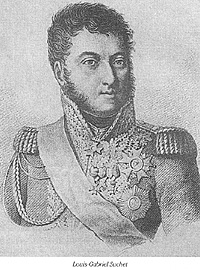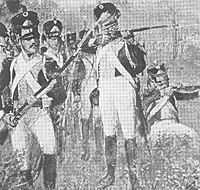Introduction and Background
In September 1808, when Napoleon was forced to intervene in
Spain after King Joseph's flight from Madrid, the Corps was
mobilised from its German cantonments. The Corps was now
commanded by Mortier, for Jean Lannes had been given command
of both V Corps and Junot's III Corps and given the task of taking
the city of Zaragoza,, which had successfully stood off one siege
already. The siege lasted from 20 December 1808 to 20 February
1809 and, at the risk of sounding anachronistic, the fighting inside
the walls mirrored that for Stalingrad 133 years later. By the end,
the city was in ruins, with the survivors and the besiegers riddled
by plague brought on by the unburied corpses.
[1]
Suchet had spent much of the siege protecting the lines of
communication away from the depredations of the nascent guerrilla
bands, but had already gained a reputation for diligence. When V
Corps was re-deployed towards the Ebro for possible employment
in the threatened Austrian War, Napoleon decided to remove Junot
from III Corps and replace him with Suchet. Suchet would now be
expected to pacify Aragon and extend French control into the
neighbouring provinces. According to Oman, notification of the
change of command did not reach Suchet until some time later, for
he had accompanied his division on its march, so that is was not
until May 19 that he reached his new headquarters. He had been
accompanied by an escort from his old division, which he retained
to bring his field strength up.
The removal of V Corps meant that the much reduced III
Corps' had had to spread itself very thinly, and Suchet's delay in
taking up his command meant that the dispirited Junot had been
reduced to garrisoning the more important towns. The Spanish
Patriot forces had not been slow to seize their opportunities, and
the Supreme Junta had nominated General Joaquin Blake as the
commander in the Coronilla, the ancient kingdom of Aragon
together with Valencia and Catalonia.
Blake was one of those Spanish Generals gamers like to
ridicule, but although he lost more often than he won (although in
La Guerra de la Independencia terms these are relative), he and his
armies kept on coming back. Blake's army was only some 10000
men, but was being reinforced. By the time Suchet arrived, the
emboldened Patriot forces had advanced to Alcaniz, some 50 miles
south east of Zaragoza. Realising that it was important to at least
face off the Spanish army, Suchet marched out on 21 May,
collected Laval on the way and arrived in front of Blake's position
on 23 May. The Orders of Battle are given below, but Suchet had
some 7300 infantry, 500 cavalry and 18 guns, whilst Blake
disposed of some 7900 infantry, 400 cavalry and 19 guns.
[3]
As can be seen from the map, Blake had stationed his
troops along a range of hills to the East of Alcaniz, with the Rio
Guadalope behind them. With only one bridge, this was a
potentially foolhardy position in the event of a collapse, one on
which Suchet hoped to capitalise. Areizaga's command composed
the Spanish right wing, with 4 battalions in the front rank and one,
with the company of Tiradores de Cartegena, in reserve. These
troops were all recruited from Aragon. In the centre, on Las Horcas,
was Lazan whose Valencians protected the Spanish artillery. The
Spanish left centre was under Roca, and he had deployed five of his
Valencian units on La Perdiguera with the remaining two acting as a
link with the small force of cavalry Blake had formed at the extreme
left wing. Blake's army was a mixture of regulars, and volunteers,
and is analysed below.
Laval's brigade from Division Grandjean formed the French
left, protected on their right by Wathier's 4e Hussards. Division
Musnier, except for the solitary battalion of 121e Ligne faced
Lazan and Roca. In reserve were the battalion of 121e, the
battallion reunis of the 40e and 64e Ligne from Suchet's old
command in V Corps, together with the two squadrons of 13e
Cuirassiers. I can find no details of where the artillery was
stationed, but I would suggest that since it does not seem to have
been used at all well that it supported all the French attacks from
rear positions.
With Blake's attention drawn to the North, Suchet shifted
his attack against the Spanish centre. The 114e and the I er Legion
de la Vistule formed colonne de division par battalion and moved
off. Suchet expected this to be the decisive attack and accompanied
it. Taking casualties from the artillery as they advanced, the five
battalions reached the foot of the hill when the Spanish artillery
changed to canister, and Lazan's infantry began firing.
Seemingly overwhelmed by the volume of fire, and with
Roca moving foward against their flank, Musnier's men wavered
then broke, falling back behind the five battalions still
uncommitted. Suchet, who had been wounded in the foot during
the attack was successful in rallying them. However, he felt unable
to renew combat, since he had suffered some 700 casualties to
Blake's 300. [4]
Blake did not press his advantage, for the French still
showed a steady front and, moreover, disposed of a respectable
mounted force that could damage him on the open plain. That night
however, Laval's brigade heard a rumour of Spanish cavalry and
broke, infecting the rest of Suchet's army with panic. By the
morning, Blake found nothing in front of him, but, being in
expectation of reinforcements, let Suchet retire back to Zaragoza.
In the days that followed, Suchet restored discipline in his
army, and concentrated his forces for the inevitable "return match"
How this went will be the subject of another article.
Battle of Alcaniz 23 May, 1809
 Only one of Napoleon's senior officers was given the honour
of being created a Marechal d'Empire for his services in the Iberian
Peninsula, Louis-Gabriel Suchet, but his first venture in command
was to end in disaster. After service during the Revolution and
under the Consulate, Suchet had led a division of Lannes' V Corps
d'Armee with distinction during the Austerlitz, Jena and Polish
campaigns. [1]
Only one of Napoleon's senior officers was given the honour
of being created a Marechal d'Empire for his services in the Iberian
Peninsula, Louis-Gabriel Suchet, but his first venture in command
was to end in disaster. After service during the Revolution and
under the Consulate, Suchet had led a division of Lannes' V Corps
d'Armee with distinction during the Austerlitz, Jena and Polish
campaigns. [1]
 After spending the morning of the 23rd carrying out a
reconnaissance and to rest his troops, Suchet began his attack by
feinting with Laval against Areizaga. This was sufficiently
worrying for Blake to redeploy his cavalry and the two detached
battalions to back Areizaga up. Wathier's 4eme Hussards were able
to chew up the hotchpotch of Spanish cavalry units when they
had the temerity to try to charge the French, who began falling
back once they had succeeded in drawing in Blake's reserves.
After spending the morning of the 23rd carrying out a
reconnaissance and to rest his troops, Suchet began his attack by
feinting with Laval against Areizaga. This was sufficiently
worrying for Blake to redeploy his cavalry and the two detached
battalions to back Areizaga up. Wathier's 4eme Hussards were able
to chew up the hotchpotch of Spanish cavalry units when they
had the temerity to try to charge the French, who began falling
back once they had succeeded in drawing in Blake's reserves.
Introduction and Background
Orders of Battle and Large Map (72K)
Wargaming the Battle of Alcaniz and Footnotes
Back to Napoleonic Notes and Queries # 16 Table of Contents
Back to Age of Napoleon List of Issues
Back to MagWeb Master List of Magazines
© Copyright 1995 by Partizan Press.
This article appears in MagWeb (Magazine Web) on the Internet World Wide Web.
Other articles from military history and related magazines are available at http://www.magweb.com